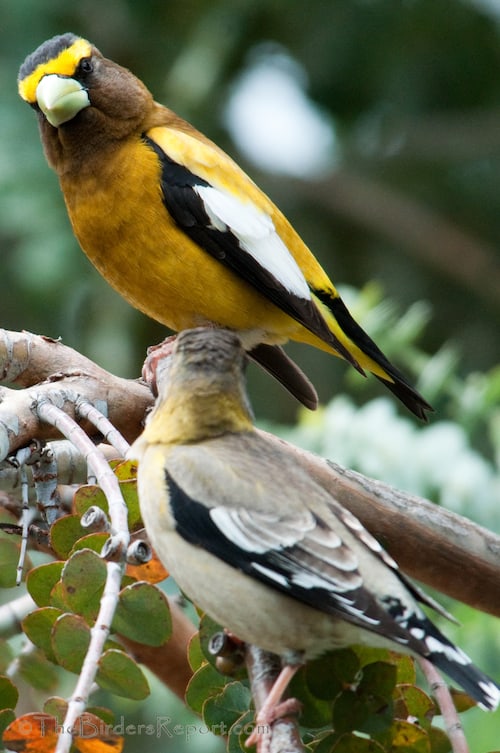
Evening Grosbeak Pair (Coccothraustes vespertinus) photos by Larry Jordan
That massive beak sported by the Evening Grosbeak (Coccothraustes vespertinus) turns from white to a pearly yellowish-green in breeding season (click on photos for full sized images).
I was fortunate to have a flock of these beauties visit me last summer. Here you can see a couple of males and several females foraging in my yard.

They are irruptive migrants meaning that they make appearances every couple of years at feeding stations throughout the United States.

If you are lucky enough to have them visit you during one of these irruptions, you might want to stock up on sunflower seed.

Enjoying their company is well worth the extra seed. They are not only gregarious and active, they are real lookers too. Check out the subtle beauty of this female Evening Grosbeak.

The male in breeding plumage is very brightly colored and easily identifiable.

Another look at the female from the back showing the gray and white pattern on her wings and her spotted tail.

Here she is in the Eucalyptus tree over the pond showing the yellow wash on her neck and flanks.

They decided that it was safe to visit the water feature where they could drink and bathe.

Note the size of the male Evening Grosbeak compared to the Lesser Goldfinch in the foreground. They are a stout bird at about 8 inches in size.

Isn’t she pretty?

Don’t they make a nice couple?

To see more great bird photos from around the world, check out Anni’s Bird D’pot at “I’d Rather Be Birdin.” Also check out the American Birding Association’s Bird of the Year!
Larry Jordan
Larry Jordan is an avid birder and amateur photographer living on the Pacific Flyway near the Central Valley of Northern California. He is a board member of his local Audubon Society and is a bird and wildlife conservationist. Larry contributes to several wildlife conservation organizations and is a BirdLife International "Species Champion." He is also Habitat Manager for the Burrowing Owl Conservation Network, an organization dedicated to the protection and restoration of the Western Burrowing Owl population in the United States. Larry has been blogging about birds since September of 2007 at TheBirdersReport.com

:max_bytes(150000):strip_icc():focal(745x369:747x371):format(webp)/elephant-safari-040324-863d6bed42bd42d5806a5aaca53d517e.jpg)
Leave a Reply